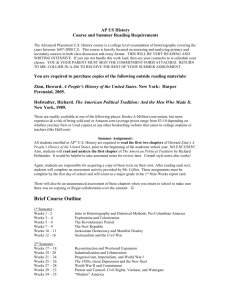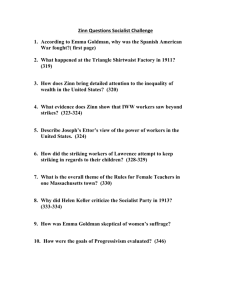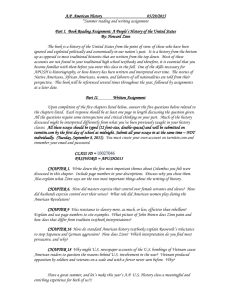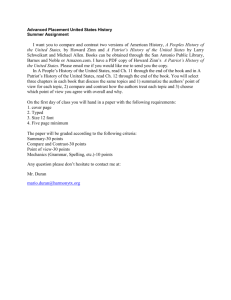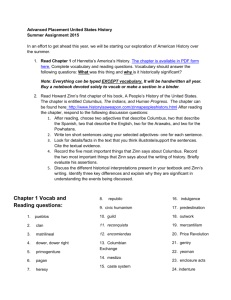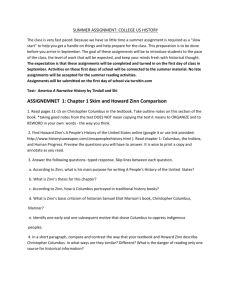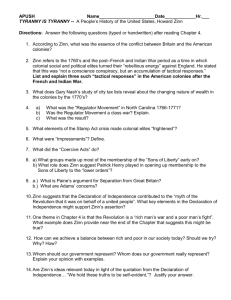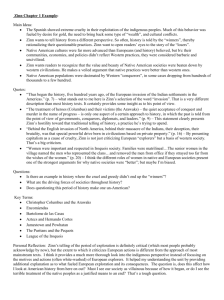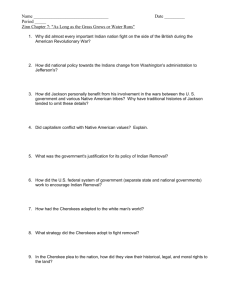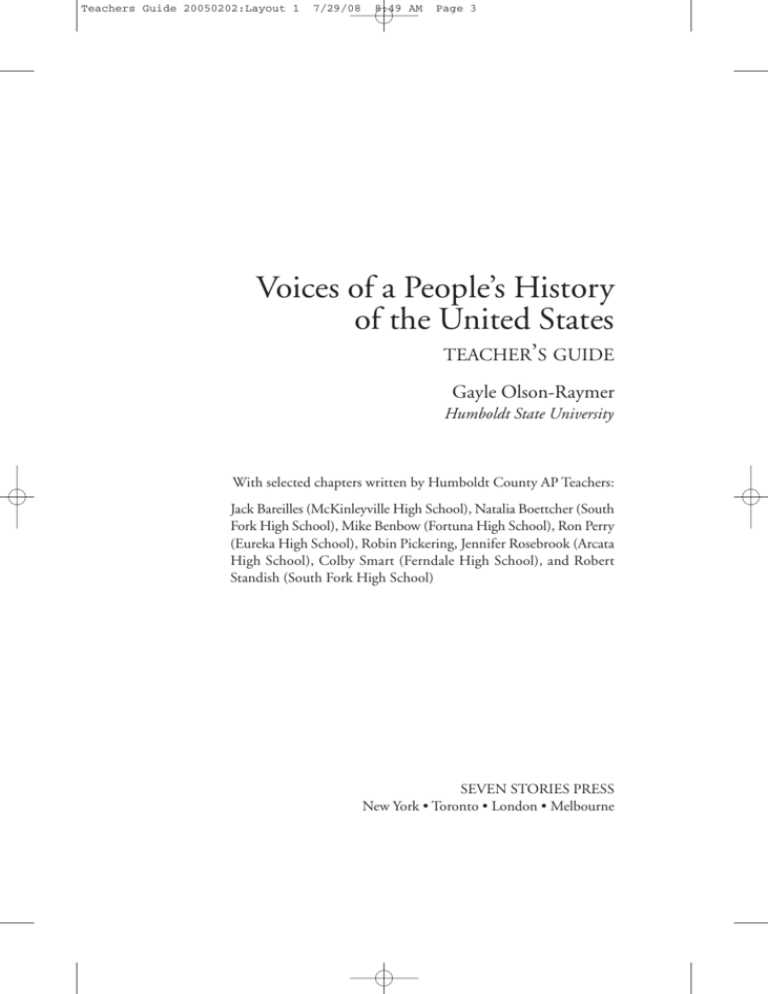
Teachers Guide 20050202:Layout 1
7/29/08
8:49 AM
Page 3
Voices of a People’s History
of the United States
TEACHER’S GUIDE
Gayle Olson-Raymer
Humboldt State University
With selected chapters written by Humboldt County AP Teachers:
Jack Bareilles (McKinleyville High School), Natalia Boettcher (South
Fork High School), Mike Benbow (Fortuna High School), Ron Perry
(Eureka High School), Robin Pickering, Jennifer Rosebrook (Arcata
High School), Colby Smart (Ferndale High School), and Robert
Standish (South Fork High School)
SEVEN STORIES PRESS
New York • Toronto • London • Melbourne
Teachers Guide 20050202:Layout 1
7/29/08
8:49 AM
Page 4
Copyright © by Gayle Olson-Raymer
All rights reserved. No part of this book may be reproduced, stored in a retrieval
system, or transmitted in any form, by any means, including mechanical, digital,
photocopying, recording, or otherwise, without the prior written permission of the
publisher.
Seven Stories Press
Watts Street
New York, NY
www.sevenstories.com
ISBN-:
--- / ISBN-: ----
College professors may order examination copies of all Seven Stories Press titles for
a free six-month trial period. To order, visit www.sevenstories.com/textbook, or fax
on school letterhead to --.
College professors who have adopted Voices of a People’s History of the United States
by Howard Zinn and Anthony Arnove as a course textbook are authorized to
duplicate portions of this guide for their students.
Design by Jon Gilbert
Printed in the U.S.A.
Teachers Guide 20050202:Layout 1
7/29/08
8:50 AM
Page 147
CHAPTER TWELVE
The Expansion of the Empire
From the first days of English settlement, the boundaries of the New World were
shaped by expansionist policies that pushed out the Indians, drove out the French
and the Spanish, and eventually overwhelmed the Mexicans. When we examine foreign policy from this perspective, it is clear that the late nineteenth century represented, not a revolutionary departure from past policies, but an evolutionary shift.
How else can we explain the three international wars and the untold number of
wars between the colonists and the Indians that preceded the American Revolution
among “the military interventions in other countries between and ”?
Despite the widespread support for “progress” surrounding the quest for
empire, many Americans spoke out against the shortsighted goals of expansionist,
interventionist, and imperialistic policymakers. Without these voices, students
may inaccurately believe that expanding the empire was a universally accepted and
supported goal of all Americans. Our goal, then, is to divest our students of this
mythical belief and to introduce them to the eloquent voices of resistance to
empire.
Document-Based Questions
CALIXTO GARCIA
.
What are General Garcia’s complaints? Do you think they are legitimate?
How do you think the United States government justified its actions in
regard to General Garcia?
. What is your impression of Garcia and his followers? How and why were
the descriptions of uncivilized, savage, and barbarian applied to them?
. Why would the victorious United States government reappoint the same
Spanish authorities who had been in Cuba prior to the revolution?
~ ~
Teachers Guide 20050202:Layout 1
7/29/08
8:50 AM
Page 148
~
LEWIS H. DOUGLASS
.
Why did some African Americans oppose the presidency and policies of
William McKinley?
. To what and to whom is Lewis H. Douglass referring when he writes about
“that section of the country from which this administration accepts dictation and to the tastes of which the President, undoubtedly, caters”? How
do the voices in other chapters of this book reinforce this assertion?
. To what governmental hypocrisy does Douglass refer in this document?
Do you agree? Explain.
THE ATLANTA, GEORGIA, A.M.E. CHURCH
.
Do you agree with the author that blacks should not enter the army because
they have no social, economic, or political stake in the United States?
. Why would “a Cuban from Havana” be “compelled to ride” in a Jim Crow
car? What was his reaction to segregation?
. Why does the author view the flag as a “miserable dirty rag”?
I. D. BARNETT, ET AL.
.
I.D. Barnett notes that his people have suffered, “since your accession to
office.” Given what you know about the Jim Crow South, was life more difficult under McKinley than under previous presidents? Explain.
. What is the author’s grievance with the administration in terms of Cuba?
. How is the hypocrisy to which I.D. Barnett alludes similar to that addressed
by Lewis Douglass?
SAMUEL CLEMENS (MARK TWAIN)
.
What is a satirist? Why is this essay an example of political satire?
. Who are the heroes of Samuel Clemens’ essay? Why do you think the
President and American newspapers were silent on the massacre of the Moros?
. What forms of racism do you find described in Clemens’ essay?
Teachers Guide 20050202:Layout 1
7/29/08
8:50 AM
Page 149
~
SMEDLEY D. BUTLER
.
Why does Smedley Butler think that war is a “racket”? Why do you think
he didn’t recognize this fact until he retired from the military?
. What are the costs of the wars that are made by millionaires and billionaires?
. This book was written thirty-seven years after the Spanish-American War.
What might have prompted Butler to write this book on the eve of World
War II?
Main Points in Voices, Chapter 12, “The Expansion of Empire”
After reading Chapter in Voices, students should be encouraged to identify what
they believe to be the main points therein. Following are four possible main points.
.
Colonial expansion into the Pacific Ocean was the logical extension of
manifest destiny.
. Two of the primary goals of foreign policy at the turn of the century were
to locate new markets for our surplus products and to gain access to raw
materials and labor.
. Although many American people supported United States imperialist ideology, a vocal and substantial minority of Americans belonging to every
socioeconomic group opposed such policies.
. Racist beliefs fueled many of the imperialist policies applied to Cuba and
the Philippines.
Main Points in Voices, Chapter 12, “The Expansion of Empire”
and in A People’s History, Chapter 12,
“The Empire and the People”
If your students are also reading A People’s History, they should be encouraged to
identify what they believe to be the main points in Chapters in both books.
Following are five additional points to be stressed when Voices and A People’s History
are used together.
Teachers Guide 20050202:Layout 1
7/29/08
8:50 AM
Page 150
~
. In the face of new foreign policies that enabled Americans to become an overseas colonial and commercial power in the Caribbean, in Latin America, in
the Pacific Islands, and in Asia, not all Americans agreed with imperialism,
and many were quite vocal in their opposition.
. The promoters of imperialism believed that America was an exemplary
model of economic, political, and spiritual development that should be
extended to other peoples and nations that were not able to solve their own
problems.
. At the end of the Spanish American War, the United States had become a
global colonial power.
. The domestic and international costs of American imperialism at the turn
of the Century were high.
. The long-range repercussions of imperialist policies of this era are still being
felt
General-Discussion Questions for Voices
While the following questions are designed for classroom discussion about all the
voices read in Chapter , they can also be rewritten and included as evaluation tools.
.
Why did the United States want to intervene in Cuba? How did the United
States government justify remaining in Cuba after the war?
. Why do you think Secretary of State John Hay referred to the Spanish
American war as “a splendid little war”?
. Why did many Americans support the imperialistic actions discussed in
this chapter?
. How does Samuel Clemens’ line, “The splendid news appeared with splendid display-heads in every newspaper in this city,” reflect his opinion of
President Theodore Roosevelt?
. Why do you think President George W. Bush cited the invasion and occupation of the Philippines as a model for the Iraq occupation in ? What
are the parallels between the two invasions?
Teachers Guide 20050202:Layout 1
7/29/08
8:50 AM
Page 151
~
. How do the voices in this chapter support Smedley D. Butler’s belief that
“war is a racket”? What is a racket? Do you believe war is a racket? Explain.
. What is a “war millionaire”? Do you think the rich have a great deal to gain
by going to war? Why do ordinary people bear the brunt of war? Explain.
. What is an “entangling alliance”?
. Which of the voices you learned about in this chapter most or least resonated with you? How and why?
General-Discussion Questions for Voices and A People’s History
These general-discussion questions are additional questions for students who have
read Chapter in both books. For all questions, discussion must focus on ways
the materials in both chapters help students formulate and articulate their answers.
. Why do you think there was so much opposition to the war with the
Philippines but very little to the war with Cuba?
. Why do you think that Theodore Roosevelt wrote in , “I should welcome almost any war, for I think this country needs one”? Do you think
we needed a war at the turn of the century? Why, or why not?
. What was the Monroe Doctrine? How does it pave the way for the imperialistic foreign policies of the late nineteenth century?
. What do you think the writer of the Washington Post editorial meant when
he wrote that at the eve of the Spanish-American war, “The taste of Empire
is in the mouth of the people” (People’s History, p. )? Do you agree or disagree with his statement?
. How does this chapter influence your understanding of Theodore
Roosevelt as both a leader and a man?
. What is the open-door-policy that Howard Zinn claims “became the dominant theme of American foreign policy in the twentieth century” (People’s
History, p. ) ?
. What “special interests” benefited from the wars with Cuba and the
Philippines?
Teachers Guide 20050202:Layout 1
7/29/08
8:50 AM
Page 152
~
. Why do you think there was so much “excitement” over the sinking of the
Maine?
. Why do you think that United States historians “have generally ignored the
role of the Cuban rebels in the war” (People’s History, p. )? Why do you
think there is little mention in traditional textbooks about the resistance of
the Filipinos to the American occupation of the Philippines?
. What was the Teller Amendment, and why was the United States able to
circumvent its provisions after the war was over? Why do you think the
Cubans eventually capitulated by agreeing to the Platt Amendment?
Evaluation Tools
SUGGESTED ASSIGNMENTS
These assignments can be adapted to meet any classroom need—homework, shortor long-term research projects, individual or group work. The end product should
be flexible, depending on teacher interest and student abilities—papers, journals,
oral reports, visual aides, and the like.
.
A great deal of mythology surrounds the newspaper circulation wars waged
by William Randolph Heart and Joseph Pulitzer before, during, and after
the war with Cuba. Find out as much as possible about both newspaper
empires in the late nineteenth century and the power of both owners. Read
articles in both newspapers leading up to war. Do you think the press was
irresponsible in its coverage of the conflict in Cuba? Was it at least partially
responsible for bringing the United States into war? Explain. Could this happen in the United States today?
. Find out more about the Anti-Imperialist League. When was it founded?
What were its goals and actions? How was it able to attract such wellknown members of the upper class? Where and how was it most influential? Are there any organizational equivalents in the twenty-first century?
If so, who do you think would be attracted to such organizations? How
are their goals similar to and different from those organizations operating
at the turn of the century? Explain.
. In I.D. Barnett’s open letter to President William McKinley, written in
Teachers Guide 20050202:Layout 1
7/29/08
8:50 AM
Page 153
~
, he decries the fact that his messages to Congress contain “incomprehensible silence on the subject of our wrongs.” Examine President
McKinley’s annual and other messages to Congress at the turn of the century. What are the primary topics of his discussions on domestic policy? On
foreign policy? Are his primary interests any different from those of
President Grover Cleveland, who preceded him in office, and President
Theodore Roosevelt, who followed? How and why? Explain.
. In his essay, Samuel Clemens (Mark Twain) describes his response to
the “Moro Massacre.” The majority inhabitants of Moro Province—the
independent Muslim Filipinos—refused to give in to United States leadership. Comparing the “uncivilized” Moros to American Indians, the
United States military ordered them to submit or to be exterminated. By
, the Moros were defeated: were killed in one battle, women and
children included. Learn more about this conflict with the Moros. Find
other primary accounts of the massacre. How do you think this incident
has contributed to contemporary feelings about the United States in the
Muslim-dominated part of the Philippines?
. Read more of Mark Twain’s political essays written at the turn of the century. How do they illustrate an anti-imperialist stance? Then find various
pro-imperialist essays from the time period. Compare and contrast their contents. Which do you find most or least persuasive? Explain.
. After examining the sample from “ interventions in the affairs of other
countries between and ,” select one of these interventions for further research. How and why did the United States intervene? What were
the results of such intervention? Did the American public generally support
the government’s actions? Who spoke out against it? What have been the
long-term repercussions of our intervention?
. Find out more about the Haitian revolution and creation of the first black
republic in . What were the causes and consequences of the revolution
on the Haitian people? What role did ordinary people play in the success
of the revolution? What lessons did United States foreign policymakers
learn from the revolution? What is the twenty-first-century relationship
between the Haitian and the United States governments? Do you think
this contemporary relationship has been shaped by the revolution?
Explain.
Teachers Guide 20050202:Layout 1
7/29/08
8:50 AM
Page 154
~
. Learn more about the origins of May Day celebrations in the United States
and overseas. What was the original purpose of May Day? How was it celebrated? Is May Day still celebrated in the United States? Is it celebrated
abroad? How and why?
. Learn more about the annexation of Hawaii. Begin by examining the
proposal
to
annex
Hawaii
at
www.alohaquest.com/archive/treaty_annexation_.htm; then the
formal letter of protest at www.hawaiiankingdom.org/protest_.shtml;
and
finally
the
congressional
joint
resolution
at
www.hawaiiankingdom.org/us-joint-resolution-.shtml. Using a search
engine of choice, find other primary documents that both oppose and support the annexation of Hawaii. What does reading these primary documents add to your understanding about the annexation of Hawaii? Then
learn more about recent attempts by some Native Hawaiians to become
independent and regain their sovereignty.
. Read George Washington’s Farewell Address. What, in President
Washington’s words, are the consequences of involving ourselves in the
affairs of other nations? Have other presidents followed his advice? How realistic was it at the turn of the twentieth century to avoid “entangling
alliances”? How realistic is it in the twenty-first century?
SUGGESTED ESSAY QUESTIONS
.
Scholars have written many books and articles about the racism that propelled the United States into war with Cuba and the Philippines, and kept
both peoples under the colonial yoke of the United States years after their
“liberation.” Using evidence from the readings, defend or refute the assertion of racism.
. Using examples from the readings, explain how the imperialistic actions
of the United States government in regard to the wars with Cuba and the
Philippines continue to influence our relations with those countries today.
. Using examples from the readings, support or refute the idea that war is profitable. Who profits most from war? Who profits least?
. Drawing from examples in the readings, explain who supported expansionist foreign policies at the turn of the twentieth century. What was the
Teachers Guide 20050202:Layout 1
7/29/08
8:50 AM
Page 155
~
basis of that support? Who resisted such policies and why? Do you see any
parallels between early-twentieth-century expansionist foreign policies and
those of the early twenty-first century? Explain.
. Using examples from the readings, explain why United States labor
unions supported the Cuban rebels in their fight against Spain, but
opposed American expansionism. Why do you think there were “mixed
reactions of labor” to the war in the Philippines? How were the two wars
similar and different? Would you have supported either or both of the wars?
Explain.
. Do you agree or disagree with the assertion that colonial expansion into the
Pacific Ocean was the logical extension of Manifest Destiny? Support your
answer with examples from the readings.
. Provide specific examples to support the contention that foreign policy at
the turn of the century was fueled by the need to find new markets for
America’s surplus products.
. Describe the domestic and international costs of American imperialism at
the turn of the century.
. At the end of the Spanish American War, the United States had become a
global colonial power. Using ample examples from the readings, explain
how and why this happened.
. In Voices, Howard Zinn states, “From the end of the Revolutionary War on,
the history of the United States is one of continuous expansion” (p. ).
Using examples from the readings, support this statement.
SIMULATIONS AND OTHER CREATIVE APPROACHES
.
Create a wall-sized map entitled, “American Imperialism: –.” Locate
all the territories that the United States added to its borders and its colonial
possessions during this time. Near the map’s legend, write five “bottom line”
themes that would describe characteristics of United States expansionist policies during this period. Present your map and themes to your classmates.
. Imagine that you are a reporter for an independent newspaper in February
and you have been asked to write a well-balanced, non-jingoistic investigative article on the sinking of the battleship Maine. Write your article and
Teachers Guide 20050202:Layout 1
7/29/08
8:50 AM
Page 156
~
read it to the class. Ask your classmates to compare and contrast what you
wrote with the way the events in regard to the sinking were actually portrayed in the Hearst and Pulitzer papers.
. Write two letters that reflect what you believe might have been President
McKinley’s response to Lewis H. Douglass and I.D. Barnett’s pleas to
oppose the growth of empire.
. Stage a discussion between George Washington, William McKinley, and
George W. Bush about the wisdom of becoming involved in “entangling
alliances.”
OTHER HOWARD ZINN TITLES AVAILABLE FROM
SEVEN STORIES PRESS
For ordering and course adoption information visit
www.sevenstories.com and www.sevenstories.com/textbook
A Young People’s History of the
United States
Adapted by Rebecca Stefoff
Zinn’s first book for young adults retells U.S.
history from the viewpoints of slaves, workers,
immigrants, women, and Native Americans,
reminding younger readers that America’s true greatness is shaped by our dissident voices, not
our military generals. The single-volume edition also includes side-bar stories of actual children
who made American history, from Anyokah, who helped bring written language to her
Cherokee people, to John Tinker, a high school student who fought all the way to the Supreme
Court for freedom of expression at school—and won.
“In many years of searching, we have not found one history book to recommend . . . until the just
published A Young People’s History of the United States. This is the edition of A People’s History that
we have all been waiting for.”—Deborah Menkart, executive director, Teaching for Change
Volume 1: From Columbus to the Spanish-American War / Paper over board 978-1-58322-759-6 $17.95 224 pages, illustrations throughout
Volume 2: From Class Struggle to the War on Terror / Paper over board 978-1-58322-760-2 $17.95 240 pages, illustrations throughout
-
Paper 978-1-58322-869-2 $19.95 464 pages, 50 b&w, illustrations and photos
Cloth 978-1-58322-886-9 $45.00 464 pages, 50 b&w, illustrations and photos
Voices of a People’s History of the United States
Second Edition
Edited with Anthony Arnove
The companion volume to historian Howard Zinn’s legendary best-selling book
A People’s History of the United States.
“Voices should be on every bookshelf. [It presents] the rich tradition of
struggle in the United States, from the resistance to the conquest of the
Americas in the era of Columbus through the protests today of soldiers and
their families against the brutal invasion and occupation of Iraq.” —Arundhati Roy
“In Voices, Howard Zinn has given us our true story, the ongoing, not-so-secret narrative of race
and class in America.” —Russell Banks
Paper 978-1-58322-628-5 $22.95 672 pages
Readings from Voices of a People’s History
of the United States
Edited by Anthony Arnove and Howard Zinn
Authors Howard Zinn and Anthony Arnove are joined on this audio
CD by Danny Glover, Sarah Jones, Paul Robeson, Jr., Lili Taylor,
Wallace Shawn, and Marisa Tomei to perform rousing words of dissent
selected from the complete anthology.
Audio CD 978-1-58322-752-7 $14.95 45 minutes
Artists in Times of War
Zinn’s essays discuss America’s rich cultural counternarratives to war, from
grassroots pamphlets to the likes of Bob Dylan, Mark Twain,
E. E. Cummings, Thomas Paine, Joseph Heller, and Emma Goldman.
“The essays are all elegantly written and relate history to the great crisis of
current times: war of aggression, western state terrorism, and obedience to
state power under the guise of patriotism.” —Tanweer Akram, Press Action
Open Media Book / Paper 978-1-58322-602-5 $9.95 160 pages
Howard Zinn on History and
Howard Zinn on War
These two companion volumes are handy pocket guides on
the power of history when it is put to the service of the
struggle for human rights, and on the meaning of war in a
world where we have so far proven unable to overcome our
primitive predilection for destroying our neighbor.
On History Paper 978-1-58322-048-1 $12.95 240 pages / On War Paper 978-1-58322-049-8 $12.95 224 pages
Terrorism and War
Edited by Anthony Arnove
Zinn explores how truth, civil liberties, and human rights become the first
casualties of war and examines the long tradition of Americans’ resistance
to US militarism.
“A significant number [of students] say that this and other books from a
radical perspective have transformed their understanding of US society,
politics, and culture.” —Darrell Y. Hamamoto, University of California, Davis
Open Media Book / Paper 978-1-58322-493-9 $9.95 144 pages
The Zinn Reader
Writings on Disobedience and Democracy, 2nd Edition
The definitive collection of Zinn’s writings on the great subjects of our time—
race, class, war, law, means and ends—now updated with thirteen recent
essays.
“A welcome collection of essays and occasional pieces by the dean of radical
American historians.”—Kirkus Reviews
Paper 978-1-58322-870-8 $21.95 752 pages
La otra historia de los Estados Unidos
“Zinn’s work is a classic of revisionist history, bringing forth voices that have
previously been muffled. He lets women, African Americans, workingclass
people, and, yes, Hispanics speak for themselves. This Spanish edition should
prove popular in both public and academic libraries.”
—Library Journal
The first Spanish-language edition of Howard Zinn’s contemporary classic, A People’s History of
the United States.
SIETE CUENTOS EDITORIAL
Paper ISBN 978-1-58322-054-2 $19.95 504 pages
THE ZINN EDUCATION PROJECT
Seven Stories is pleased to support the Zinn Education Project, a collaboration between
Rethinking Schools and Teaching for Change, dedicated to introducing middle school and high
school students to a more accurate, complex, and engaging understanding of United States
history than is found in traditional textbooks and curricula. Visit the web site to see how you
can bring Zinn’s teaching into the classroom, showing students that history is made not by a
few heroic individuals, but by people’s choices and actions. http://www.zinnedproject.org
A People’s History for the Classroom
Bill Bigelow
Activities and projects for middle school and high school classrooms, inspired by Zinn’s A People’s
History. Available from The Zinn Education Project: http://www.zinnedproject.org

